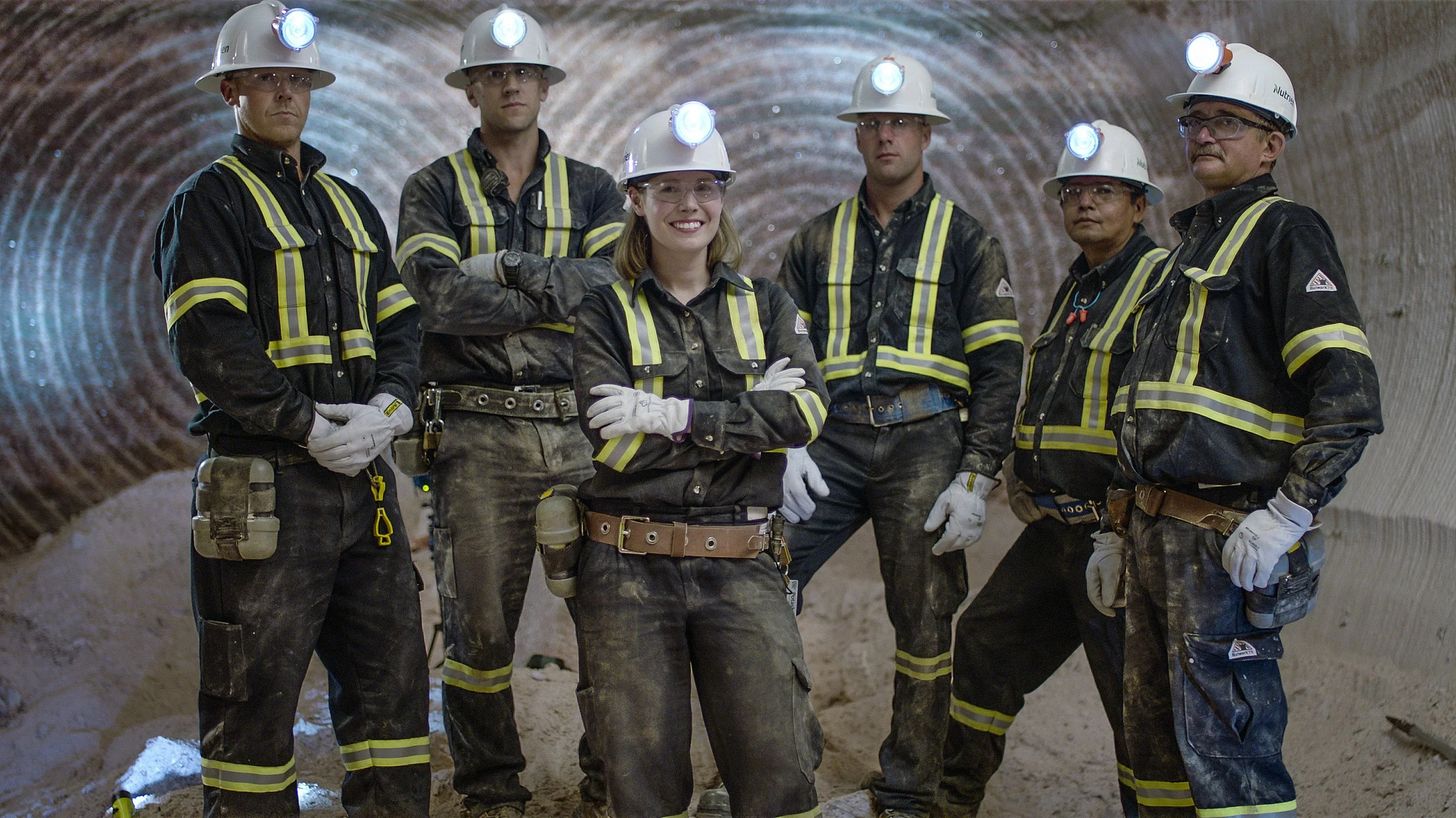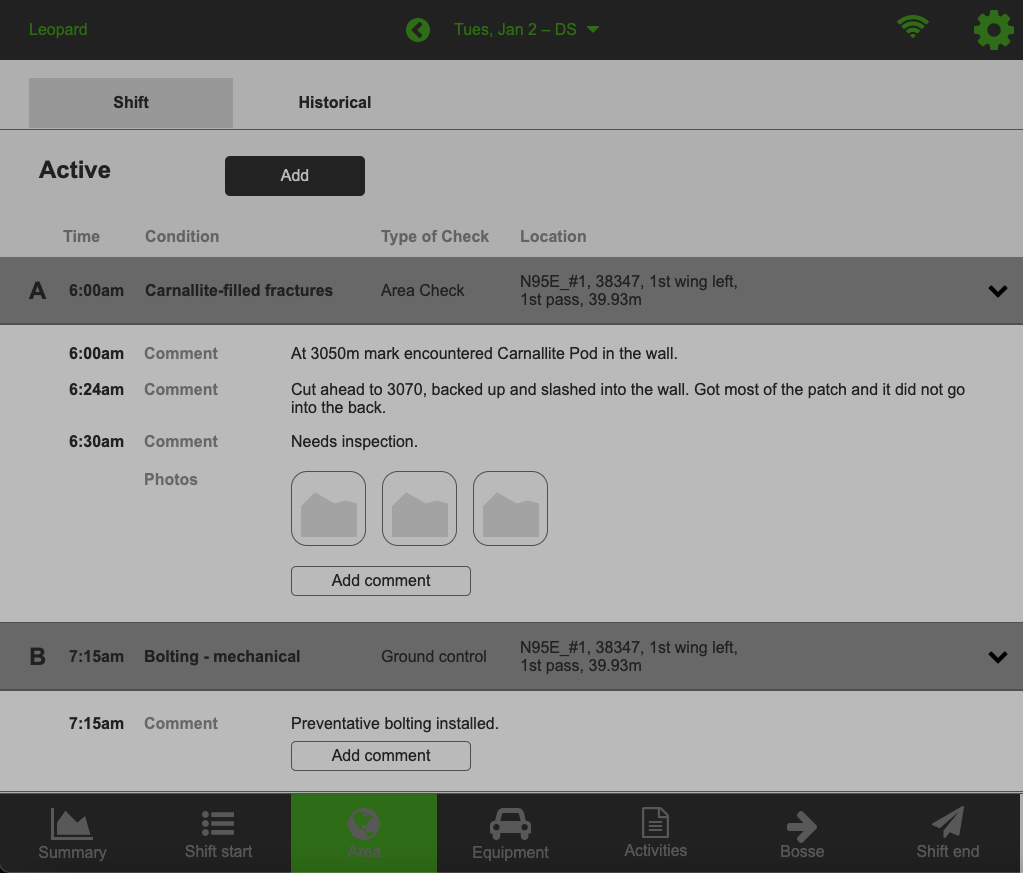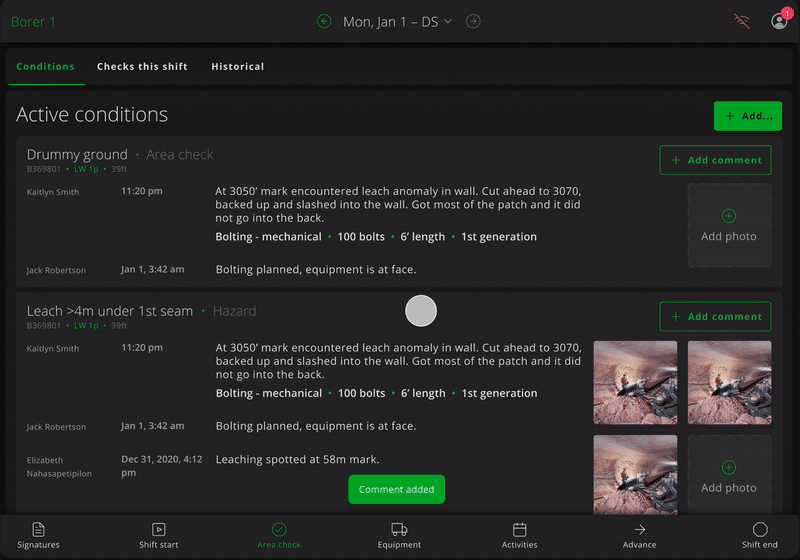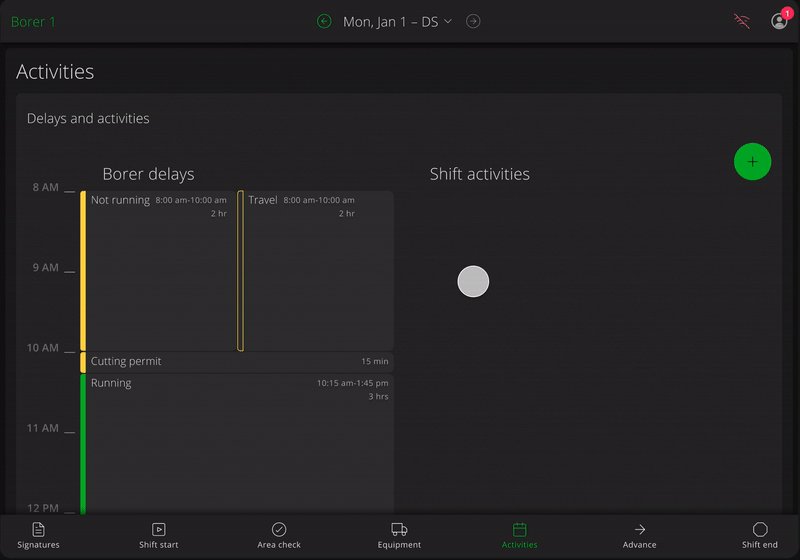Nutrien
Nutrien produces and distributes over 27 million tonnes of potash, nitrogen and phosphate products worldwide. This publicly traded company is on a mission to help increase food production in a sustainable manner.
The challenge
How might we simplify communication, create efficiencies, automate reporting, and replace outdated and inconsistent processes, across five Canadian mines, while maintaining their uniqueness?
Paper based processes
Unique databases and electronic processes dating back to 2003
Products
MineSight is a potash operations platform with two flagship custom web apps
Borer: A tablet based app that allows miner operators to enter information underground
Ops: A app designed for large monitors in the control room whereby supervisors and leadership can manage, plan & assist production
Borer app seen on tablet. Ops app seen on desktop monitor.
Context
-

Underground
Underground in the mine is dirty and dusty. There is minimal light—just from the miner. Therefore, dark theme was utilized. A design pattern was utilized leveraging the existing Material UI light theme at Nutrien. Differences were required to accommodate conditions ie using transparencies instead of strokes for inputs.
-

Control room
The control room has many monitors transmitting critical information. The person in the control room needs access to critical information quickly without information overload.
Project details
Duration: 2.5 years
Role: Design Lead
Cost: approx. 7.5M
-
Axure
Figma
Affinity Creative Suite
Jira
Miro
Office suite -
Scrum Master
Project Managers
Product Owner
Front & Back-end BAs
Front & Back-end Devs
QA Specialists
Change Management/Training -
Regulatory
Budgetary
Compliance: accessibility, branding, privacy, etc.
Software: third party integrations
Stylistic: design system, photos, etc.
Business requirements
Approach
Research
Current state analysis
Discovery workshops
Interviews
Requirements gathering
Site differences analysis
Value add
Project roadmapping
Data creation
Team working agreement
Brand materials
Ideation
Persona creation
Journey mapping
User flows
Collaboration
Sketching
Implementing
Defining requirements
Prioritizing features
QA testing
Launch
Prototyping & Iterating
Design patterns & component creation
Lo-hi fi wireframes & interactive prototypes
Usability testing
A/B testing
Stakeholder engagement
UX Goals
Focus on UX so miners, sites & users are championed
Phases
-
The MineSight platform was built off of one code base. We developed the applications sequentially. Moving from Lanigan to Cory and Vanscoy. Building /customizing Borer and Ops as we moved from one location to the next.
-
Cory and Vanscoy were developed on top of the Lanigan codebase. Each site having it’s own flavour aka unique features and data. The Cory site being detail oriented and A-type personalities.
-
All about simplicity. Let’s focus on capturing the required data in as little time as possible.
-
We’re promised to be a large undertaking with unique processes.
-
We’re a large mine and a large commute to boot.
Initial Discovery Process
18 weeks (workshops every 2 weeks)
-
8 Workshops
10 Stakeholders
5 Sites -
Engage stakeholders
Understand current processes
Map out future processes
Gain insights from end users
Design new systems -
Focus on specific functionality
Wireframe walkthroughs
Review design iterations -
Engage stakeholders
Establish functional & business requirements
Determine design specifications
Detailed project plan
Initial Usability Testing
-
Rounds of testing
6 rounds per site
-
Users
5 users per site/per app/per round
-
Numbers
122 Total tasks to complete
14 Semi-complete
23 Incomplete
1 N/A
-
Outcomes
Adjust labels, order of fields, flow between screens, etc.
Location of features
Data requirements & calculations
Informed integration requirements
Removing processes that do not pertain to primary users
Identified unique reporting needs
User Personas
The personas’ goals, of having one system that streamlines the production process, mirrored testimonials post-release. It is key to keep user needs centered throughout the process.
Participatory design
Co-designing a new & complex feature with site stakeholders is fundamental to understanding use cases & dependencies
Subject matter experts can save time & increase alignment amongst the broader team. This allows for deeper understanding which allows me to be a better advocate for the stakeholder. I understand the importance of the feature and communicate it well to the working team. This can impact its presence or absence in the project roadmap.
Iterating Features
Usability testing allows you to learn what what does and what doesn’t work.
Through usability testing with primary users, I learned that a feature needed to be removed. Originally, secondary users identified the Time Usage Model (TUM) being required. However, after testing with primary users, I learned that they were unaware of the TUM. The feature was removed since it distracted from the primary users’ goals.
Leading product vision
The product team was experiencing misalignment, so I took it upon myself to find a solution. I created and led a daily design meeting were we discussed features and requirements, reviewed designs, co-designed as a team, and provided critique. This helped create a well-gelled team.
Communication across teams
Mine regulations require anyone going to a mining location to review existing hazards for safety purposes. I was tasked with creating an area to review existing hazards and have employees sign off that they have read them. You are able to see who has reviewed the active and remediated conditions along with a map of outstanding hazards. The hazards carry over shift to shift until they have been resolved. The live data ensures miners are always aware of hazards.
Building on previous work
If a hazard was created on a previous shift, but remains active, a miner can add additional details. Collaborating on work started by another crew is possible. You can add ground control, photos, comments, and remediate the hazard.
Improving productivity through reporting
Complex third party integrations were required with RtDuet and Pi. It was important to make the process simple for users despite offline status, data sync issues and manual add processes. A simplified user experience was created through technical updates and utilizing visual indicators. The user experience will continue to evolve as the budget and time constrains change.
Post-Release Success Metrics
-
1-1.5 K
Daily users
-
8.5
Overall rating
-
100%
Of operators agreed that all processes had been captured
-
100%
Incident-free safety record
-
100%
Product adoption
Results
The rollout was coined, by Nutrien leadership, as one of the smoothest in Nutrien’s history.
Robust usability testing minimized changes required post-release.
These apps created the foundational standards which the MineSight platform continues to grow.
Upcoming project: MineSight SIC
Upcoming project: MineSight Hoist














